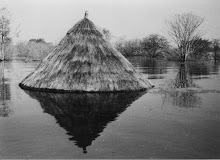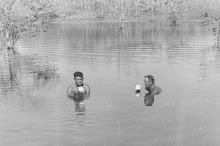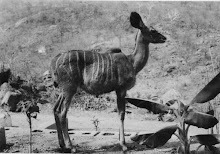 May 1959: A young Waterbuck Doe is trapped in one of the nets which has been spread across an island. These nets are used mainly to capture "Impala" (a species of Antelope) as the latter animals will not take to water.
May 1959: A young Waterbuck Doe is trapped in one of the nets which has been spread across an island. These nets are used mainly to capture "Impala" (a species of Antelope) as the latter animals will not take to water.
Thursday, March 26, 2009
Photo Of The Month - Waterbuck Doe
 May 1959: A young Waterbuck Doe is trapped in one of the nets which has been spread across an island. These nets are used mainly to capture "Impala" (a species of Antelope) as the latter animals will not take to water.
May 1959: A young Waterbuck Doe is trapped in one of the nets which has been spread across an island. These nets are used mainly to capture "Impala" (a species of Antelope) as the latter animals will not take to water.
Wednesday, March 25, 2009
An AWOL Update
Hello to all! This is just a brief post to let you know that I haven't fallen off the face of the planet, and will be back soon to continue working on this blog and telling the story of Operation Noah.
I was off travelling through South America from May through to December last year and my life has been somewhat hectic since my return. Things will settle down in a few weeks, and then I'll have more time to dedicate to this blog.
In the mean time, I'll treat you animal lovers to some videos of an orphaned oso melero (tamandua) that I was fortunate enough to nurse while doing some conservation work of my own at El Puma Ecological Park in Posadas, Argentina. She was brought in to the clinic at 3 days old - umbilical cord still attached! - after her mother was shot by farmers. My Spanish was so rubbish at this point that I didn't really understand what I was agreeing to when I nodded and said "Sí, sí" and suddenly I found myself landed with 24-hour care of her. Oso melero literally translates to "honey bear", so naturally I named her Winnie.

Sadly, after almost three weeks of three-hourly syringe feeds (even throughout the night) of a mixture of crushed dog biscuits, banana, honey, powdered milk, baby formula and warm water, and despite having gained weight and showing a number of signs of improvement, Winnie died. Apparently this species is notoriously difficult to keep alive in captivity - even as fully grown adults. The nutrition requirements of their natural diet of honey and termites is extremely difficult to replicate. I was told right from the outset that she had only had extremely slim chances of survival, having likely missed out on too much of her mother's colostrum milk, but was nonetheless devastated when she didn't make it.
Pre-feed, searching for "las mamas" (breasts):
With her snout in the trough:
...and now exhausted from all that hoovering, she curls up into a ball for a nap:
And taking her first wobbly steps:
I was off travelling through South America from May through to December last year and my life has been somewhat hectic since my return. Things will settle down in a few weeks, and then I'll have more time to dedicate to this blog.
In the mean time, I'll treat you animal lovers to some videos of an orphaned oso melero (tamandua) that I was fortunate enough to nurse while doing some conservation work of my own at El Puma Ecological Park in Posadas, Argentina. She was brought in to the clinic at 3 days old - umbilical cord still attached! - after her mother was shot by farmers. My Spanish was so rubbish at this point that I didn't really understand what I was agreeing to when I nodded and said "Sí, sí" and suddenly I found myself landed with 24-hour care of her. Oso melero literally translates to "honey bear", so naturally I named her Winnie.

Sadly, after almost three weeks of three-hourly syringe feeds (even throughout the night) of a mixture of crushed dog biscuits, banana, honey, powdered milk, baby formula and warm water, and despite having gained weight and showing a number of signs of improvement, Winnie died. Apparently this species is notoriously difficult to keep alive in captivity - even as fully grown adults. The nutrition requirements of their natural diet of honey and termites is extremely difficult to replicate. I was told right from the outset that she had only had extremely slim chances of survival, having likely missed out on too much of her mother's colostrum milk, but was nonetheless devastated when she didn't make it.
Pre-feed, searching for "las mamas" (breasts):
With her snout in the trough:
...and now exhausted from all that hoovering, she curls up into a ball for a nap:
And taking her first wobbly steps:
Subscribe to:
Comments (Atom)




